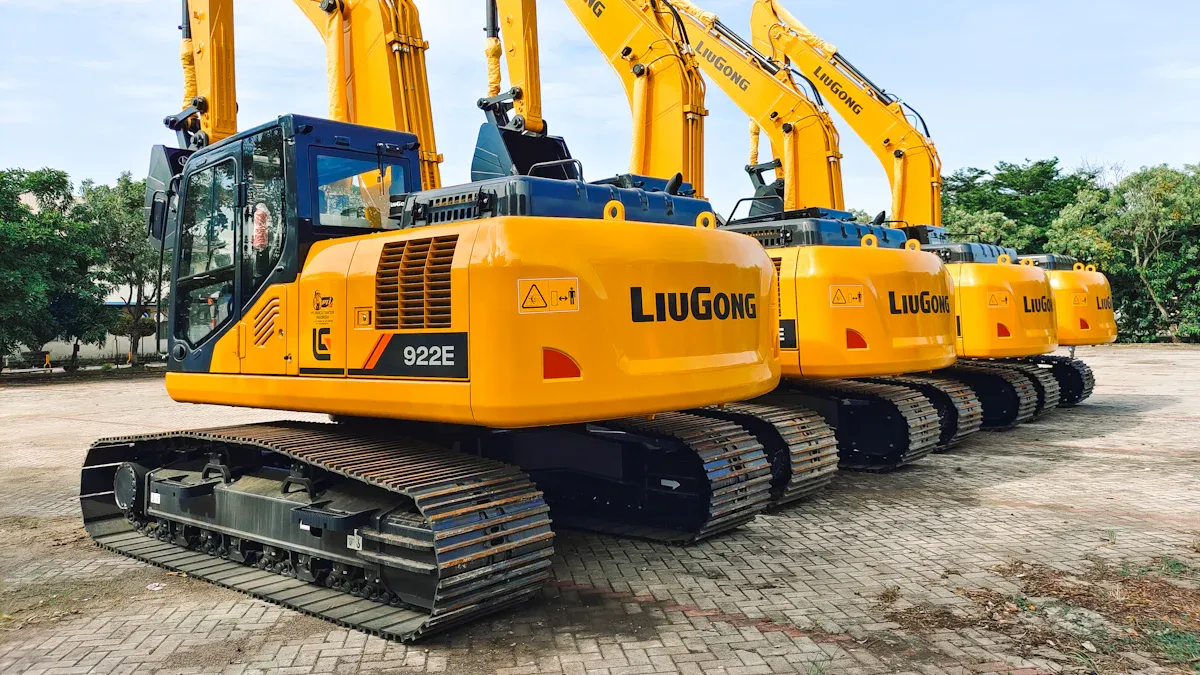
Rubber excavator tracks make a noticeable difference on the job. They minimize ground damage, keeping surfaces intact during operation. Operators enjoy a smoother ride thanks to reduced vibrations and lower noise levels. These tracks also prove cost-effective, requiring less maintenance compared to steel options. Their adaptability across terrains, from urban sites to remote areas, sets them apart.
Key Takeaways
- Rubber tracks cause less harm to the ground. They work well in places like cities and gardens.
- Drivers feel more comfortable using rubber tracks. They make less noise and shake less.
- Rubber tracks save money. They need fewer repairs and last long, giving good value.
Rubber vs. Steel Excavator Tracks
Material and Design Differences
Rubber and steel excavator tracks differ significantly in their material composition and design, which directly impacts their performance and suitability for various tasks. Steel tracks are made from high-strength alloys, offering exceptional durability and resistance to wear. Their rigid design ensures stability and uniform load distribution, making them ideal for heavy-duty applications. On the other hand, rubber tracks are crafted from reinforced rubber compounds, often with embedded steel cords for added strength. This flexible design allows them to adapt to uneven surfaces, reducing ground pressure and minimizing damage to delicate terrains.
| Feature | Steel Tracks | Rubber Tracks |
|---|---|---|
| Wear and Durability | Exceptional durability, outlasting rubber tracks. | Less durable than steel, more prone to wear. |
| Counterweight and Balance | Heavier, lowers center of gravity for stability. | Lighter, may require additional counterweights. |
| Traction and Load Transfer | Uniform load distribution, reduces point loading. | Flexes, can increase point loading on uneven terrain. |
| Repair and Maintenance | Fewer repairs needed, less downtime. | More frequent repairs and maintenance required. |
| Cleaning and Upkeep | Easy to clean, low upkeep. | More difficult to clean, higher upkeep. |
| Versatility | Best for harsh conditions. | Versatile, performs well on soft or bumpy ground. |
Steel tracks excel in durability and stability, but their weight can increase fuel consumption. Rubber tracks, while lighter and more versatile, may require additional counterweights to maintain balance during operation. These differences highlight the importance of choosing the right track type based on the specific needs of the job.
Typical Applications for Rubber and Steel Tracks
The choice between rubber and steel tracks often depends on the operating environment and the nature of the work. Steel tracks are the go-to option for rugged terrains, such as rocky or abrasive surfaces. Their durability and resistance to high-impact conditions make them indispensable for heavy construction, mining, and forestry projects. Additionally, steel tracks allow for the replacement of individual damaged shoes, extending their lifespan and reducing downtime.
Rubber tracks, however, shine in urban and residential settings. Their ability to minimize ground damage makes them perfect for landscaping, roadwork, and projects on soft or delicate surfaces. They also reduce noise and vibration, creating a more comfortable work environment for operators and those nearby. This versatility allows rubber tracks to perform well across a variety of terrains, from muddy fields to paved roads.
| Criteria | Steel Tracks | Rubber Tracks |
|---|---|---|
| Durability and Maintenance | Highly durable, requires regular maintenance | Less durable, minimal maintenance required |
| Traction and Stability | Superior traction in loose terrains | Enhanced stability on soft surfaces |
| Noise and Vibration | Higher noise and vibration levels | Significantly reduces noise and vibration |
| Cost-Effectiveness | Higher initial cost, longer lifespan | Lower upfront cost, may require frequent replacements |
Key Advantages of Rubber Excavator TracksMinimizing Ground Damage
Rubber tracks are a game-changer when it comes to protecting the ground beneath heavy machinery. Unlike steel tracks, which can leave deep ruts or scratches, rubber tracks distribute the machine’s weight more evenly. This reduces ground pressure and helps preserve delicate surfaces like grass, asphalt, and concrete.
- Industries like construction and agriculture rely on rubber tracks for their ability to minimize surface damage.
- Contractors prefer them for projects in urban areas where protecting pavement and landscaping is critical.
- Rubber tracks are also easier to clean and less prone to debris buildup, saving time and effort during maintenance.
By reducing ground damage, rubber tracks not only protect the environment but also help operators avoid costly repairs to surfaces after a job is done.
Enhancing Operator Comfort and Productivity
Operating heavy machinery can be exhausting, but rubber tracks make it a smoother experience. They absorb vibrations and reduce noise levels, creating a more comfortable environment for operators. This comfort translates directly into better productivity.
Studies show that operators using rubber tracks experience less fatigue and can focus on their tasks for longer periods. In fact, productivity can improve by up to 50% because operators take fewer breaks and maintain higher-quality work throughout the day. With rubber tracks, long hours on the job feel less like a chore and more like a manageable task.
Cost-Effectiveness in Maintenance and Replacement
Rubber tracks offer a cost-effective solution for maintaining excavator performance. While steel tracks may last longer, they often come with higher upfront costs and more expensive repairs. Rubber tracks, on the other hand, are easier to replace and require less frequent maintenance.
Their design minimizes wear and tear on the machine itself, reducing the likelihood of costly repairs to other components. For operators looking to balance performance with affordability, rubber tracks provide an excellent return on investment.
Versatility Across Different Terrains
One of the standout features of rubber tracks is their ability to perform well on a variety of terrains. Whether you’re working on soft soil, rocky surfaces, or paved roads, rubber tracks adapt to the conditions. This versatility makes them a popular choice in industries like construction, agriculture, and even mining.
Rubber tracks provide superior traction, ensuring the machine stays stable and efficient regardless of the surface. Unlike steel tracks, which can struggle on softer ground, rubber tracks excel in environments where flexibility and adaptability are key.
Noise Reduction for a Better Work Environment
Nobody enjoys the constant clatter of steel tracks on hard surfaces. Rubber tracks significantly reduce noise levels, creating a quieter work environment. This benefits not only the operator but also anyone nearby, such as other workers or residents in urban areas.
A quieter machine means less stress and distraction, allowing operators to focus on their tasks. For projects in noise-sensitive areas, rubber tracks are the clear choice for maintaining peace and productivity.
Addressing Concerns About Rubber Tracks
Durability and Longevity Compared to Steel
Rubber tracks are often questioned for their durability compared to steel. While steel tracks are undeniably tough, modern rubber tracks are engineered to last. Manufacturers use reinforced rubber compounds and embedded steel cords to enhance strength and resilience. These tracks can withstand significant wear and tear, even in demanding environments.
Rubber tracks also excel in adapting to various terrains. Their flexibility reduces stress on the track material, which helps extend their lifespan. For operators who prioritize both performance and longevity, rubber tracks offer a reliable solution that balances durability with versatility.
Performance in Heavy-Duty and Extreme Conditions
Rubber tracks are no strangers to tough jobs. They perform exceptionally well in heavy-duty conditions, thanks to specialized tread patterns that improve grip and traction. These treads are designed to handle slick mud, loose gravel, and other challenging surfaces.
- High-performance rubber tracks enhance machine efficiency in tough conditions.
- Aggressive, self-cleaning treads minimize slippage, ensuring better power utilization.
- Their versatility reduces downtime, keeping operations smooth and productive.
In extreme environments, rubber tracks prove their reliability. Engineering tests show that elastomer components can endure harsh conditions like extreme heat, cold, and corrosive environments. This makes them suitable for applications in deserts, high altitudes, and even underwater scenarios.
| Evidence Description | Key Points |
|---|---|
| Fatigue analysis solutions | Ensure rubber components withstand extreme demands, such as tank track pads. |
| Simulation of extreme conditions | Predicts longevity under underwater pressures, temperature shifts, and more. |
| Durability in harsh environments | Designed to endure extreme heat and cold for versatile applications. |
Balancing Weight and Efficiency
Rubber tracks strike a perfect balance between weight and efficiency. Their lighter design reduces the overall weight of the machine, which improves fuel efficiency and makes transportation easier. Despite being lighter, they don’t compromise on performance.
Lifecycle analyses reveal that rubber tracks significantly reduce vibrations and ground-borne noise. This not only enhances operator comfort but also improves machine stability. For example, rubber composite systems can reduce vertical vibrations by up to 96%, ensuring smoother operations and less wear on the machine.
| Metric | Rubber Composite Systems (RCSs) | Concrete Systems (CSs) |
|---|---|---|
| Peak Acceleration Reduction | 38.35% – 66.23% | N/A |
| Vertical Vibration Reduction | 63.12% – 96.09% | N/A |
| Ground-borne Vibration Reduction (dB) | 10.6 – 18.6 | N/A |
Rubber tracks deliver efficiency without adding unnecessary weight, making them a smart choice for operators who value performance and practicality.
Tips for Choosing and Maintaining Rubber Excavator TracksSelecting the Right Tracks for Your Machine
Choosing the right rubber tracks for your excavator can make all the difference in performance and longevity. Here are some key factors to consider:
- Size: Always ensure the tracks are the correct size for your machine. Tracks that are too small can wear out prematurely, while oversized tracks may not fit properly. Check the existing rubber tread for sizing information.
- Brand and Reputation: Opt for tracks from reputable suppliers. High-quality tracks reduce the risk of damage to your machine and ensure better performance.
- Terrain and Application: Match the tracks to the terrain and the type of work. For example, some tracks are better suited for soft soil, while others excel on rocky surfaces.
- Price: While it’s tempting to go for cheaper options, investing in durable tracks can save money in the long run by reducing replacement frequency.
By considering these factors, operators can select tracks that meet their specific needs and maximize their machine’s efficiency.
Best Practices for Maintenance and Longevity
Proper maintenance is essential for getting the most out of your rubber tracks. Follow these best practices to extend their lifespan:
- Track Tension: Adjust the tension according to the machine size. For instance, a 3.0–6.0-ton machine should have a sag depth of 12–20mm (0.47–0.79″). Overly tight tracks can cause tearing, while loose tracks accelerate wear.
- Regular Inspections: Check for wear and tear frequently. Early detection of issues can prevent costly repairs.
- Cleaning: Remove debris from the undercarriage after each shift. This prevents abrasive materials from causing unnecessary wear.
- Operator Training: Train operators to use the equipment mindfully. Avoiding sudden turns or excessive stress on the tracks can significantly reduce wear.
- Storage: Store tracks in a cool, dry place to protect them from environmental damage.
By following these steps, operators can ensure their rubber tracks remain in top condition, reducing downtime and saving money over time.
Rubber excavator tracks bring a host of advantages to the table. They reduce surface damage, improve operator comfort, and save costs while adapting to diverse terrains. Here’s why they’re a smart choice:
- Enhanced Traction: Rubber tracks provide superior grip on various surfaces, ensuring smooth movement.
- Reduced Ground Damage: They preserve landscapes, making them ideal for sensitive environments.
- Lower Noise Levels: A quieter operation benefits both operators and nearby communities.
- Improved Comfort: Operators experience less fatigue, boosting productivity.
- Fuel Efficiency: Rubber tracks require less power, saving money and reducing environmental impact.
With proper maintenance, operators can extend the lifespan of their tracks to 1,000–2,000 hours. Regular care prevents downtime and maximizes return on investment. For more information or assistance, reach out:
- Email: sales@gatortrack.com
- WeChat: 15657852500
- LinkedIn: Changzhou Hutai Rubber Track Co., Ltd.
FAQs
What are the signs that my rubber tracks need replacement?
Look for cracks, missing tread, or exposed steel cords. If the tracks slip frequently or cause uneven movement, it’s time to replace them.
Can rubber tracks handle wet or muddy conditions?
Yes! Rubber tracks excel in wet and muddy environments. Their flexible design and specialized treads provide excellent traction, reducing slippage and improving overall performance.
How do I store rubber tracks during the off-season?
Store them in a cool, dry place away from direct sunlight. Keep them clean and ensure they’re not under tension to prevent unnecessary wear.
Media Contact
Company Name: Gator Track Co., Ltd.
Email: Send Email
Country: China
Website: https://www.gatortrack.com/





